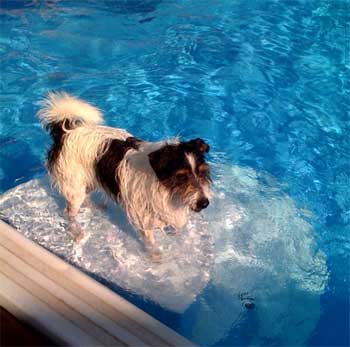The Dog’s Days Of Summer
Summer can be a great time for you and your dog to have fun together spending time outdoors, but hot weather can spell trouble for dogs. Heat and humidity can raise canine body temperature to dangerous levels. Dogs cannot release heat like humans do by sweating through their skin. Some heat is released by sweating through their foot pads and nose, but panting is their main means of cooling themselves. The most common hot weather hazards are heat stress and dehydration, sunburn, and heat stroke – all preventable. Heat stress can take a serious toll on a dog’s health, sunburn is painful at best, and heat stroke can kill.
 To reduce the chance of canine summer heat stress, schedule your walks in the early morning or evening hours, the coolest parts of the day. Steer clear of long walks and strenuous exercise for your dog on very hot, high humidity days. A combination of even moderate temperatures and high humidity can stress a dog as much as the mid-day sun. If your dog pants more heavily than usual, slow down, stop, find shade, offer water, and rest for a while. No matter where you are, when temperatures climb, provide plenty of water. Your dog’s panting releases body heat but this process can also dehydrate him. Keep his water fresh and cool throughout the day. Along with plenty of cool water, ventilation, air circulation, and shade are crucial to dogs who are confined to pens, crates and kennels. Any dog can suffer from heat stress, but most susceptible are the very young and old, dogs with a history of heat stress, breeds with flat faces or short noses, dogs who are overweight, physically inactive, or have a respiratory or cardiovascular condition. The signs of heat stress include heavy panting, warm, dry skin, thick saliva, an anxious expression, fatigue, failing to respond to you in the usual fashion.
To reduce the chance of canine summer heat stress, schedule your walks in the early morning or evening hours, the coolest parts of the day. Steer clear of long walks and strenuous exercise for your dog on very hot, high humidity days. A combination of even moderate temperatures and high humidity can stress a dog as much as the mid-day sun. If your dog pants more heavily than usual, slow down, stop, find shade, offer water, and rest for a while. No matter where you are, when temperatures climb, provide plenty of water. Your dog’s panting releases body heat but this process can also dehydrate him. Keep his water fresh and cool throughout the day. Along with plenty of cool water, ventilation, air circulation, and shade are crucial to dogs who are confined to pens, crates and kennels. Any dog can suffer from heat stress, but most susceptible are the very young and old, dogs with a history of heat stress, breeds with flat faces or short noses, dogs who are overweight, physically inactive, or have a respiratory or cardiovascular condition. The signs of heat stress include heavy panting, warm, dry skin, thick saliva, an anxious expression, fatigue, failing to respond to you in the usual fashion.
Never leave your dog in the car unattended. Despite many warnings, each summer brings numerous accounts of dogs dying of heat stroke because they were left in a car. Even at a pleasant 70-80 degrees outside, the inside of a car acts as an oven, and the temperature can rise to 120 degrees or much higher in a matter of minutes. Leaving the windows open a little will not help. If you absolutely must bring your dog with you on errands, make sure you bring another person who can stay in the running, air-conditioned car with the dog. Otherwise – do your dog a favor and leave him home!
The signs of heat stroke include profuse panting, warm nose and foot pads, glazed eyes, rapid pulse, a dark red tongue and gums, dry mucous membranes, fever, immobility and unconsciousness. A dog’s normal temperature is about 100.5-101.5 degrees. Damage to the brain, organs and the body’s cellular system may be irreversible when the body temperature reaches 106-107 degrees. Your rapid response may save your dog’s life in the case of heat stroke. Immerse in cool water – whatever’s handy – stream, pond, fountain, tub, wading pool. If you can’t immerse them, wet the dog thoroughly and continuously, pouring cool water over their body, beginning with the head and extremities, using things like a hose, a watering can, a bottle – again, whatever’s handy. You can also apply wet towels to abdomen, groin, head, neck and legs. Get the dog to a veterinary clinic as soon as possible for an assessment.
Dogs can get sunburned too! If you’re out with your dog on a sunny hot day, find plenty of shade time. Hairless dogs, short-haired dogs, and dogs with light-colored fur are most susceptible to sunburn. Vulnerable areas are the nose, the tips of their ears, and bellies. Sunburn is not only painful but can lead to open areas and skin sores with the potential for infection. Sunscreen made especially for pets can be applied to those vulnerable areas. Do a small test area initially to rule out sensitivity to any ingredients. Pet sunscreen even comes in a variety of SPF’s!
There are many products available to help your dog stay comfortable and safe in the hot summer months. These include cooling mattresses, cooling jackets, cooling bandanas and neck wraps – a personal favorite of mine for my dogs, as the blood circulates close to the surface at the neck and throat.
Keeping our pets cool involves a certain amount of common sense. Why take a dog out into the heat of the day unless it’s to go for a swim or a wade in the shade?!
Prevention is the key to keeping your dog safe during hot, humid weather.
Sue Sanders, CPDT-KA July 2010
email Sue with your thoughts...your comments may be posted.
Hot Weather Safety



